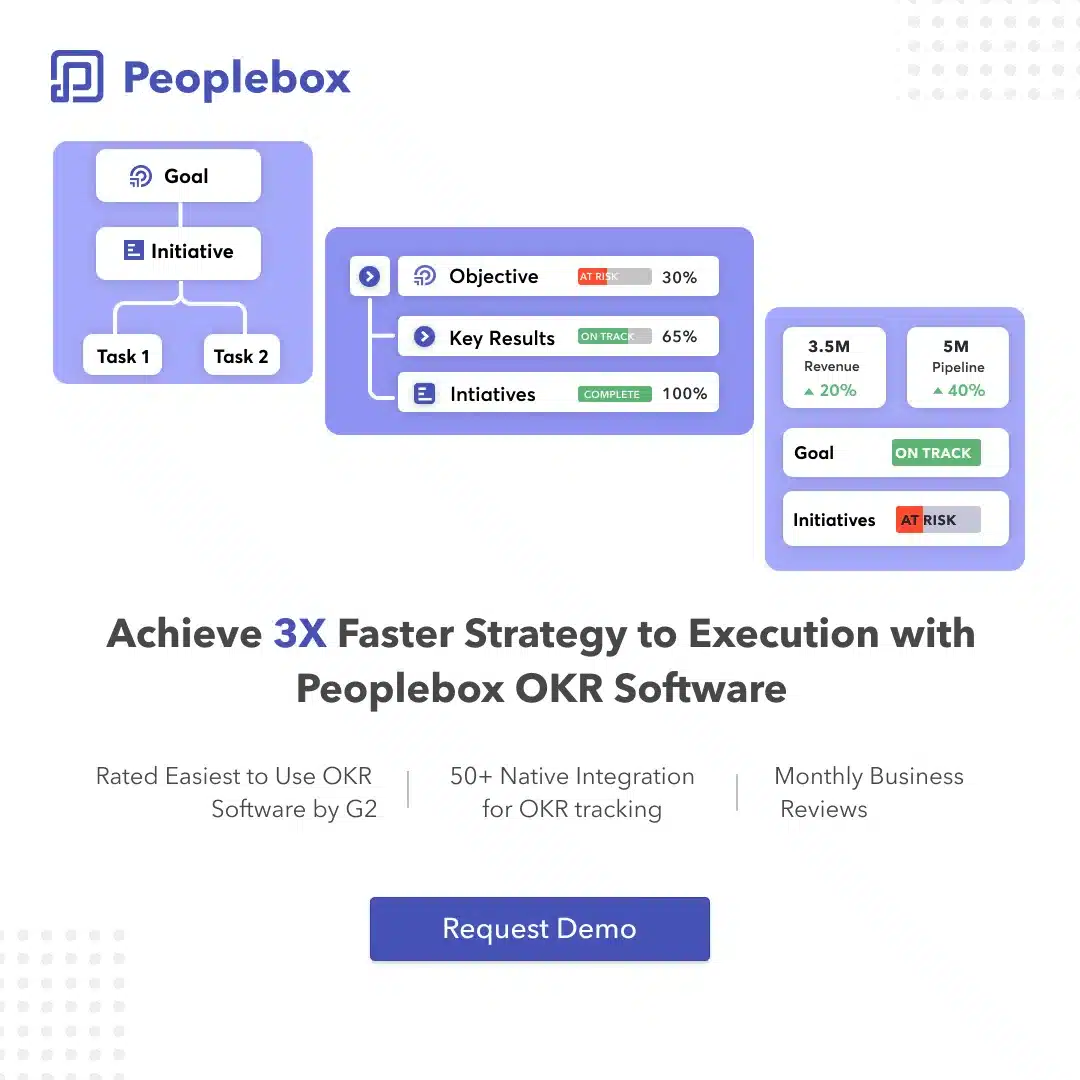Since the start of modern capitalism, people and businesses have set goals, but only recently has a formalized system been developed.
The OKR process (Objectives and Key Results) is an agile framework that allows you to set effective and achievable goals, track progress, and ensure that everyone on the team is on the same page.
In this blog post, we will discuss what OKRs are, why they’re important, how to create them effectively, and how to monitor their progress.
We will also discuss addressing some of the common issues that can arise during the OKR process. As a final step, we will evaluate the goals’ effectiveness using OKRs and make necessary adjustments.
Setting goals is essential, as we all know. Even more important is putting in place a system that allows you to achieve those goals. This is where OKRs come in.
For the ease of understanding, we have divided the blog into
- Understanding the OKR method and its history?
- Its process, framework, and examples
- Challenges in its implementation
Let us explore now the OKR journey
What are OKRs?
OKR stands for Objectives and Key Results, and they are a framework that allows you to set practical and achievable goals.
They are essential for businesses because they provide a way to track progress and ensure that everyone on the team is on the same page.
For individuals, OKRs can help you focus on what’s important and achieve your objectives.
History of OKRs

The OKR method was first developed by Andy Grove, the former CEO of Intel. It originated from Peter Drucker’s management method, MBO (Management By Objective), designed to help Intel achieve its objectives and key results.
The OKR method has since been adopted by many other businesses and organizations, including Google, Apple, Facebook, and LinkedIn.
Google’s growth from 40 to 100000 employees is attributed mainly to the OKR method. Needless to say, Google is also the reason OKRs are now so popular with companies such as Spotify, Netflix, and Samsung.
As a framework, OKRs provide a consistent and cohesive structure for setting, tracking, and achieving goals. OKRs have three key components:
Objectives: These are the overarching goals that you want to achieve. They should be specific, measurable, achievable, relevant, and time-bound.
Key Results: These are the specific actions or milestones that you will take to achieve your objectives. They should be quantifiable and have a due date.
Initiatives: These are the projects or tasks you will undertake to achieve your key results. They should be actionable and have a due date.
The OKR philosophy must align with the company’s mission and vision. OKRs should also cascade down from the top level of the organization to individual contributors.
Usually, the management takes the onus of 40%, and the rest of the organization owns 60% of OKRs.The OKR process flow typically looks like this:
- The company’s management creates OKRs
- The OKRs are cascaded down to the team level
- The OKRs are reviewed and adjusted periodically
- The OKR process and its framework

OKR process and its framework
Now that we understand what OKRs are and why they’re essential let’s look at the OKR process and its framework.
As we mentioned earlier, OKRs have three key components: objectives, key results, and initiatives. Let’s look at each of these in detail.
Objectives: Objectives are the overarching goals that you want to achieve. They should be specific, measurable, achievable, relevant, and time-bound.
Some examples of objectives are:
- Increase market share by X%
- Launch new product by the date
- Increase customer satisfaction by X%
Key Results: Key results are the specific actions or milestones you will take to achieve your objectives. They should be quantifiable and have a due date.
Some examples of key results are:
- Increase website traffic by X%
- Increase conversion rate by X%
- Increase customer satisfaction rating by X%
Initiatives: Initiatives are the projects or tasks you will undertake to achieve your key results. They should be actionable and have a due date.
Some examples of initiatives are:
- Create a social media campaign
- Redesign the website
- Implement a new customer satisfaction survey
OKR models are best suited for short goal cycles. The most common goal cycle is quarterly, but some organizations use monthly or weekly OKRs.
The critical thing to remember is that OKRs should be reviewed and adjusted periodically to ensure that they are still relevant and achievable.
There are a few different ways to set OKRs. The most important thing is to find a method that works best for you and your team.
The three most common methods are:
- Top-down: In this method, OKRs are set by senior leadership and then cascaded down to lower-level employees.
- Bottom-up: In this method, OKRs are set by individual employees and then aggregated up to the company level.
- Hybrid: In this method, OKRs are set by a combination of top-down and bottom-up approaches.
Once you’ve decided on a method, it’s time to start setting OKRs. The following are a few tips to keep in mind when creating OKRs:
- Be realistic: It’s essential to set goals that challenge you and your team but are still achievable.
- Be specific: Objectives and key results should be clear and concise.
- Be measurable: Make sure you track and measure progress towards your objectives and key results.
- Align OKRs with company strategy: OKRs should support and be aligned with your company’s overall strategy.
- OKRs should be reviewed and adjusted periodically: As mentioned earlier, OKRs should be reviewed and updated regularly to ensure that they remain relevant and achievable.
“The great danger for most of us lies not in setting our aim too high and falling short, but in setting our aim too low, and achieving our mark.” –Michelangelo.
The OKR process can seem daunting at first, but it doesn’t have to be. What is important is that we aim for the 100% application of the method, and even if we only get 70% there, it is still a vast improvement over 0%.
How to create OKRs

Now that we’ve looked at the components of OKRs, let’s look at how to create practical and achievable OKRs.
To implement OKRs, it is essential to keep these five elements in check.
1 OKR cycle
The organization should establish an OKR cycle to review and update OKRs regularly. This will help avoid the common pitfall of letting OKRs become outdated and irrelevant. A typical review cycle for OKRs can be between 2 weeks to a quarter.
2 OKR planning
OKRs should be created with input from all members of the team. This will ensure that everyone is bought into the OKRs and committed to achieving them.
It is also essential to keep the OKRs achievable. If they are set too high, then team members will become discouraged. Conversely, if they are set too low, there is no incentive to achieve them. Most importantly, OKR goals must align with the company goals.
3 OKR Weekly Check-ins
To ensure that everyone is on track to achieve the OKRs, it is essential to have regular check-ins. A status check allows for any issues to be identified and addressed quickly.
Check-ins also allow for course corrections to be made if necessary.
4 OKR review
At the end of the OKR cycle, it is essential to review the OKRs to see what was achieved and what could be improved. This feedback should be used to inform the next cycle of OKRs.
5 OKR retrospective
It is also essential to have a retrospective at the end of the OKR cycle. This allows for lessons to be learned and improvements to be made.
The retrospective should identify what went well and what could be improved. The OKR process is iterative, and it is crucial to keep these five elements in mind when creating OKRs.
Organizations must have trained resources for any process to be effective; OKRs are no different. A few key roles are critical to the success of OKRs.
The Owner: The owner is responsible for creating the OKRs and ensuring that they are achievable. They are also responsible for ensuring that the OKRs align with the company goals.
The Facilitator: The facilitator ensures that the OKRs are reviewed and updated regularly. They are also responsible for facilitating the OKR check-ins and retrospectives.
The Team Members: The team members are responsible for achieving the OKRs. They are also responsible for providing input into the creation of OKRs.
While organizations can have internal training for the OKR process and methods, the alternate option is to hire an OKR champion.
An OKR champion can provide the following benefits:
- They have a wealth of experience in implementing OKRs
- They can help to create OKRs that are achievable
- They can help to ensure that the OKRs align with the company goals.
When looking for an OKR consultant, it is essential to find one that has a proven track record in implementing OKRs.
Click here to read about How to Roll Out OKRs for First Time
Let us look at some OKR examples to give you a better understanding of how OKRs work.
Let us look at some OKR examples to give you a better understanding of how OKRs work.
Google OKRs
Objectives:
Increase revenue from online advertising
Key Results:
Achieved 20% growth in online advertising revenue
YouTube OKRs
Objectives:
Grow the number of YouTube channels with over a million subscribers
Key Results:
Achieved 30% growth in the number of YouTube channels with over a million subscribers.
Tracking OKRs

Tips for tracking progress and ensuring that everyone is on the same page – OKR tools.
OKRs are a great way to keep everyone on the same page and ensure that everyone is working towards the same goals.
However, tracking OKR progress can be difficult, especially if you don’t have the right tools in place.
Before we get to the tools, consider a few scenarios if we don’t have the right tools in place.
Click here to read about why manual OKR tracking is not beneficial for long run
OKRs can become difficult to track.
- If there is no clear way to see which objectives have been completed and which ones are still in progress, it can be difficult to tell if everyone is on track. This lack of visibility can lead to frustration and confusion among team members.
- Another scenario that can occur is when people forget to update their OKRs. This can happen for several reasons, such as failing to update the system or not having time. Either way, it can lead to inaccurate tracking and make it difficult to see how well the team is doing.
Now that we’ve seen some of the challenges that can arise from not having the right tools in place let’s look at some tools that can help you track OKRs.
One tool that can be helpful is a goal tracker. This tool can help you see which objectives have been completed and which ones are still in progress.
It can also provide insights into how well people are doing against their goals.
There are a few different ways to track OKRs:
- Use a spreadsheet or Google Docs to track OKRs. This can be effective for small team but as the company grows tracking okrs on google sheet is not feasible
- Use a dedicated OKR tracking tool. There are several different tools available, both free and paid. Choose one that will work best for your team and ensure that everyone has access to it.
- Use a project management tool. Many project management tools, such as Asana or Trello, have OKR tracking features built-in. This can be a great way to keep track of OKRs if your team is already using one of these tools for other purposes.
No matter which method you choose, it’s vital to ensure that everyone on your team knows the OKRs and knows how to access the tracking method you’re using.
Dedicated OKR tracking tools can be beneficial, as they often have features that make it easy to share OKRs with team members and track their progress.
OKR Software - Rated 4.8 on G2
Empower your managers to be a better leader with essential performance tools & personalized coaching support.
Challenges in implementing OKRs

Common issues that can arise during the OKR process and how to address them:
- Lack of clarity about what OKRs are and how they fit into the bigger picture. OKRs should be aligned with the company’s strategy and objectives. They should be SMART goals that everyone can understand and buy into.
- Poorly defined or unrealistic goals. OKRs must be specific, measurable, achievable, relevant, and time-bound.
- Too many OKRs. OKRs should be limited to a handful of the most important goals for the company or team to focus on.
- Lack of buy-in from employees. OKRs need to be communicated effectively, and everyone needs to be on board with them to work.
- No system for tracking progress. OKRs need to be tracked and monitored regularly to ensure that they are met.
- Failure to review and adjust OKRs. OKRs should be reviewed regularly to ensure that they are still relevant and achievable. Adjustments may need to be made if they are not.
If you’re having trouble with your OKRs, address these common issues. You can get your OKRs back on track and achieve great things with a bit of effort!
Evaluating OKRs
The importance of periodic review and adjustment of OKRs to ensure that they continue to be relevant and useful.
OKRs need to be reviewed regularly to ensure that they are still relevant and achievable. The review process should involve all team members, not just the manager or creator of the OKRs.
It is also essential to adjust OKRs as needed in response to changes in the business environment or company priorities.
There are a few different ways to approach OKR adjustments. One is to simply adjust the targets for each goal, either making them more or less challenging as needed.
Another option is to add or remove goals from the OKR list altogether. Finally, it may be necessary to change how progress is tracked for a particular goal, especially if the original method is no longer working well.
Click here to read about why frequent OKR review meetings are important
Whatever approach is taken, it is vital to keep the following in mind:
- OKRs should be ambitious but realistic
- They should be specific and measurable
- Everyone should understand and buy into the OKRs
- Progress toward OKRs should be tracked and reported regularly
- Adjustments should be made as needed to ensure that OKRs remain relevant and achievable.
If you follow these guidelines, you will be well on your way to setting and achieving goals with OKRs.
CONCLUSION
Organizations trying to leverage OKRs need to keep the following in mind:
OKRs should be ambitious but realistic, specific, and measurable; everyone should understand and buy into the OKRs, progress toward OKRs should be tracked and reported regularly, adjustments should be made as needed to ensure that OKRs remain relevant and achievable.
With these guidelines in mind, you can effectively set and achieve goals with OKRs. Larger organizations have more to gain from the OKR process than smaller businesses, but OKRs can benefit companies of any size.
OKRs can help to improve communication and collaboration, focus on the most important goals, and track progress over time.
The key is to get started and keep adjusting as needed to ensure that your OKRs remain relevant and achievable.
OKR is a simple yet powerful tool for setting and achieving goals. It is important to remember to review and adjust OKRs regularly to ensure that they remain relevant and achievable. By doing so, you can maximize the benefits of using OKRs in your business.








